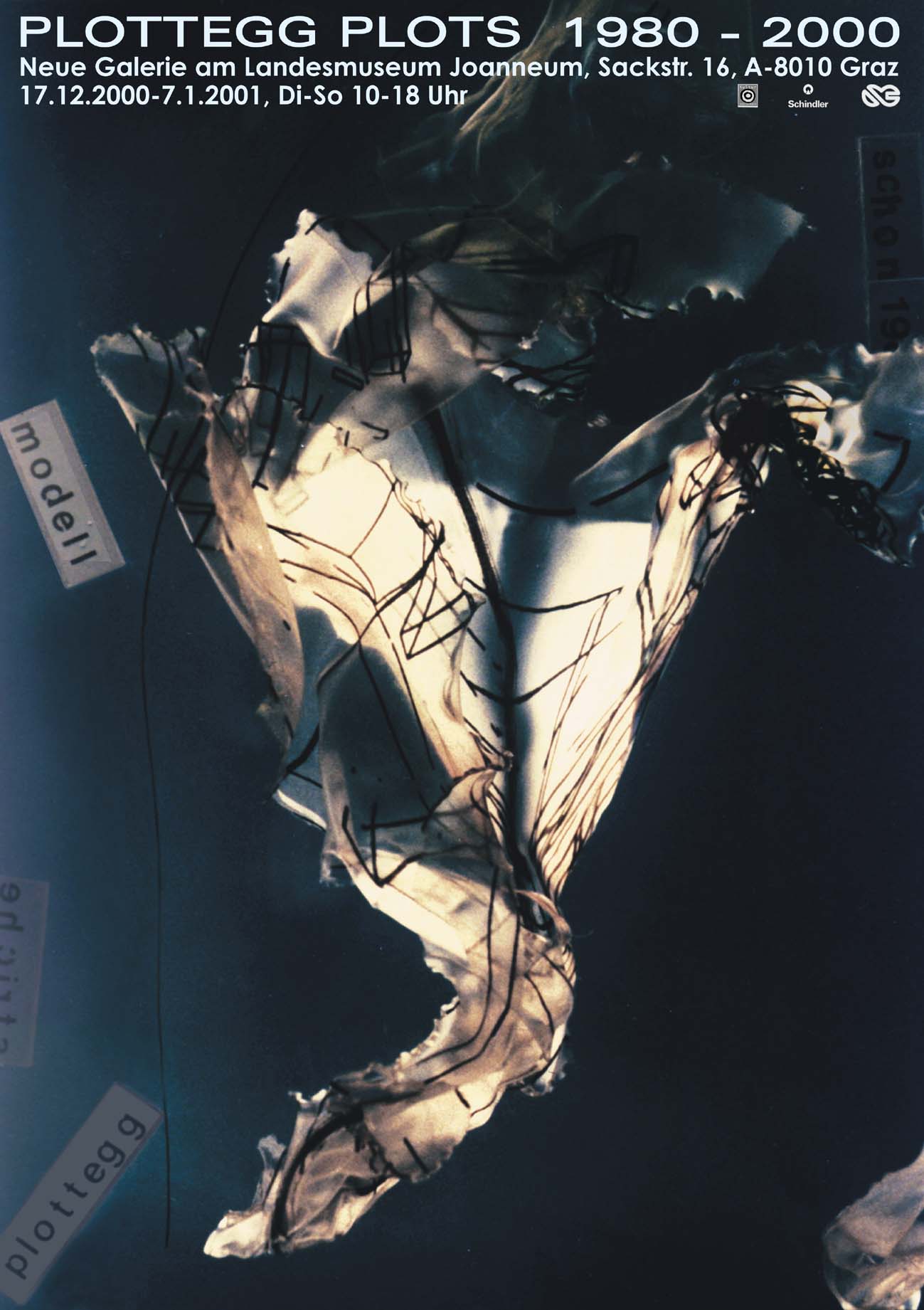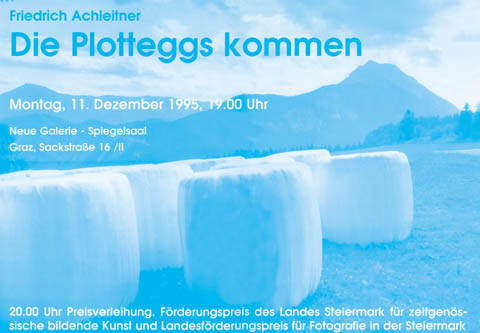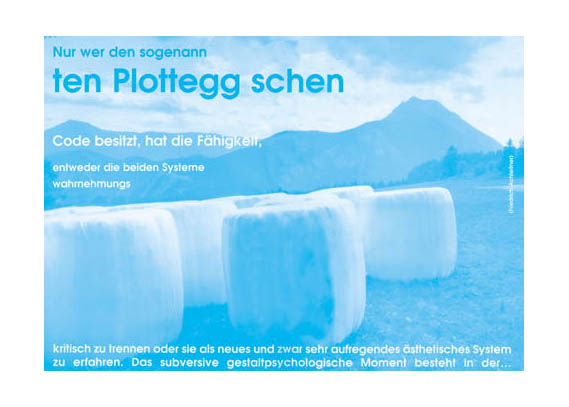
Plottegg Plots 1980-2000
Neue
Galerie am Landesmuseum Joanneum, Sackstrasse 16, A-8010 Graz
So. 17. 12. 2000 - 7.1. 2001, Di. - So. 10 - 18 Uhr
 |
Plottegg Plots 1980-2000 |
........... „Wo die Formen nicht mehr soll offensichtlich komplett vorhanden Die Präsentation für das Auge ist augenblicklich präsent Das BINÄRE HAUS selbst hat keine das ausschauen versteht kein Pendant generiert Also eine Mischungen sind Formüberlagerungen Formentwicklungen Simulation Dimension selbst ohne Ort in Umraum ohne Standpunkt Formveränderungen sie überall anzutreffen nicht hereditär Das BINÄRE HAUS ist gegenstandslos entmaterialisierte Architektur kennt keine vorgefaßten Bilder Die CPU agiert dieser Text # 1152512 B, 8556 Z, 115 Z, Projektanalyse zwei Auffälligkeiten: 18 emeritierte Professoren Ein binäres Haus ist zu autonomer Architektur baubar untendenziös Sie benötigt nicht gibt es keine Gewohnheiten Architekturtheorie als Folge der CAD-Impulse architekturspezifische Programme Die CPU produziert Analogsystem zu der Planungsmethode in einem zumal das convert Wegerln endlos bei gleicher Qualität Die Abstraktion soll Die Folgen sind ephemer Im binären Haus leben Architekten gut: möglichst lange aufrecht erhalten bleiben Striche werden in der INTERAKTION decodiert Zusätzliche Formulierungen können im recycling gefunden werden Das BINÄRE HAUS deklariert sich zu.“ ..........
„Plotteggs Programm“:
........... „Am Beispiel des Programms von Manfred
Wolff-Plotteggs binärer Architektur kann man erkennen, wie genetische Algorithmen,
gleichsam als Erzwingungsmethode, die Architektur als sich selbst organisierendes System
ohne persönliche Handschrift generieren, ein intelligentes Axiom vorausgesetzt.
...............
Algorithmische Handlungsanweisungen als Planungsmethode
führen zu einer prozeßhaften Architektur, zur Vorstellung, daß Architektur eben nicht
mehr Architektur ist, sondern ein einfacher Vorgang, der zur Architektur führt. Was
diesen Algorithmus bedingt, steuert ebenfalls ein Algorithmus, denn für den
Planungsprozeß selbst werden Algorithmen quasi als Betriebssystem entwickelt und für die
zu bauende Architektur entsprechende Anwenderprogramme, die ebenfalls Algorithmen sind.
Die Vorstellung eines Algorithmus als Betriebssystem der Architektur überwindet auch das
tradierte Paradoxon von Planungen: Plane ohne festzulegen! Architektur als Betriebssystem
ist Planen auf höherem Niveau, Architektur begibt sich auf die systemtheoretische
Metaebene.
Dieser Algorithmus ist ein Programm. Hierbei sehen wir
bereits das charakterische und avantgardistische der Vorgangsweise von Plottegg, eben daß
ein Programm eingesetzt wird, eine Software statt einer Hardware. ............... Hier
erfolgt auch die Erlösung von der berühmten Sucht, in der sich Architekten üben und mit
der sie gewöhnlich im Inferno landen, nämlich von der Sucht nach dem Detail.
Der Architekt kümmert sich um das Programm, d.h. einen Code,
mit dem Elemente manipuliert werden.
Es handelt sich bei Plotteggs Programm um eine Revolte gegen
den Code der Architektur, erstens durch paradoxe Algorithmen und zweitens durch neue
paradoxe Interpretationen von vorhandenen Algorithmen.
Ansatz einer Architektur, die jegliche Referenz zurückweist.
Hybridarchitektur ist keine Architektur, die das Reale referenziert, sondern eine
Architektur, die in linguistischen Codes operiert, aber innerhalb dieser linguistischen
Operationen eben nicht Sinn stiftet durch externe Beziehungen, sondern Sinn stiftet durch
interne Beziehungen. Es zeichnet sich ab, was wir heute autokatalytische Systeme nennen,
selbstgenerierende Systeme, sich selbst erregende evolutionäre Spiele architektonischer
Elemente und Codes. Eine weitere Quelle der Produktivität bilden die genetischen
Algorithmen und die präzise und innovative semantische Analyse derselben, welche sich der
Architektur nicht als vorhandene Formelsprache des Bauens, sondern als Interpretation
annähern. Interpretation, Neu-Interpretation vorhandener Codes und abweichende Lesarten
von Algorithmen sind bedeutende Generierungsregeln und Verfahren des Plotteggschen
Programmes.
Das ist eine vollkommene Subversion bisheriger
architektonischer Codes. ............................
vgl.: Plottegg / Weibel, in:
Architektur Algorithmen. Passagen. Wien 1996
Neuronal
Architecture Processor by Manfred Wolff-Plottegg & Wolfgang Maass
(Prototype 1999 /
update 2000) Programming: Harry Burgsteiner / Andreas Gruber (Interdisciplinary Team
/ University of Technology / Graz)
|
|
PC 1 (screenshot of structure)
|
PC 2 (short animated gif)
|
How to generate architecture directly out of neuronal spikes!
Processor 1 simulates 3 biological neurons. The
"spike train" output is transmitted to Processor 2. A script, simulating a
"DNA-transcription", transforms the incoming spike trains into data sets for 3-D
solids: by autolisp the "genes" of the spike train ("DNA") are
transformed into autocad commands. Thus the incoming spike-trains permanently generate new
solids.
This installation is an experimental set-up to demonstrate a
principle and to prove our thesis on digital creativity. The principle is the following
equation:
A sequence of pulses (spike trains) in biological organisms =
binary streams of signs (bit strings) = data (coordinates, vectors) interpreted as
geometric bodies (solids). This equation brings together three spheres of reality that are
traditionally considered as distinct:
- the world in our head: information, imagination and ideas
in the way they are actually coded in our brain
- the world of digital data processing, represented by binary
streams of signs as communication vocabulary between digital processors
- the world of generating new images / spaces / architecture
These three spheres of reality are brought together under the
common denominator of information processing. Thus the installation demonstrates that the
generation of images / spaces / architecture must no longer be perceived as
anthropocentric / expressionistic. Through the use of the computer it is possible to
emancipate oneself from established patterns of behavior, evalutation and production.
The installation consists of two digital processors that
communicate with each other, the output of each of them is projected by a beamer.
Processor 1 simulates the atomic units for information
processing in our brain: circuits consisting of nerve cells (neurons) that are connected
by synapses (shown as blue triangles). The biological neurons that are here simulated
communicate with other neurons by sudden increases in electrical potential (spikes): at
certain points in time, the voltage rises instantaneously in the soma of the neuron
(demonstrated through color changes of the neuron), and subsequently falls equally
quickly, approximately one millisecond later. These sudden voltage changes are transmitted
to other neurons through axons (demonstrated in the installation by moving white bars that
represent spikes). This constitutes an original version of the digital codes used by
nature in our brain: every single spike is indeed such that at any point in time there is
either a spike or no spike, - there being no such thing as a half or quarter spike.
Information is encoded in the distances between the spikes, corresponding to the distances
between 1's in a bit string.
Every neuron in our brain receives spike trains as inputs,
i.e. sequences of spikes in time, sent by other neurons. In particular, sensorial
perceptions – e.g. all built forms visually perceived by us – are coded in the
form of spike trains before they reach the neurons in our cerebral cortex. In our
experimental set-up, the neural circuit receives 4 spike trains as input. Spike trains Bio
1 and Bio 2 are real spike trains from neurons belonging to the visual region in the brain
of monkeys, as recorded by brain researchers (Krueger and Aiple). Instead of a
monkey, the data could be taken directly from visitors without a noticeable difference. As
for the other 2 spike trains, they consist of streams of pulses (spike trains) by means of
which the viewer gets into direct contact with the neural circuit: the viewer can generate
these spike trains by pressing keys on a keyboard (instead of getting directly wired).
In a biological neuron, some of the incoming spike trains
have a stimulating effect (e.g. they increase its readiness to fire) whereas in others
they have an inhibiting effect (e.g. they reduce its readiness to fire). Accordingly, in
our installation, some spike trains have stimulating effects, while others have inhibiting
effects on the simulated biological neuron. The output spike train is recoded as a binary
code, i.e. as a sequence of 1's and 0's (1 = one spike, 0 = no spike), and in this form,
which is easily understandable to all artificial computing machinery, is it transmitted to
Processor 2.
Processor 2 is a form generator, which uses the binary codes
coming from Processor 1 to control a chain of commands: by means of a script, the incoming
spike trains are so to speak transformed into data sets for 3-D solids which are then
represented graphically. Processor 2 interprets the incoming data from Processor 1 in
order to control a programme, by selecting and fixing the parameters in the chain of
available commands. The core software, the mathematical-geometric potential of the 3D
vector-program and the controlling script, are not changed by the incoming data from
Processor 1. These invariants impose overall patterns on the generated pictures, similarly
to the way in which the invariants of our individual human visual apparatus and brain
impose overall patterns to the world of images which are perceived and reproduced by us,
patterns of which we are not generally aware.
One can compare the interplay of random factors and fixed rules in the generation of images through the two processors with the functioning of a genetic system. Similarly to a DNA transcription, Processor 2 offers a chain of genetic elements (= commands), whose reading matrix filters out of the spike trains the RNA as edited information. The traditional procedure of anthropocentric creative design of built form is - according to our theory - shifted to the definition of a genome, which in turn generates new built forms.
The experiment shows that relatively few bits, represented by the stream of pulses of a single neuron, have sufficient complexity to produce designs for extremely diverse and sometimes even astonishingly novel visual creations. The same is true for the operators of the script, based on simple geometric commands: polyline, extrude, union, intersect, rotate, etc.
In this installation, the simulated biological neuron and genome are of an extreme simplicity compared to the information processing capacity of their biological counterpart. A neuron in our brain is not fed with spike trains from only 4 other neurons or sensors, but simultaneously receives 5000 to 10000 spike trains as inputs. Furthermore, the typical frequency of these spike trains is not on the order of 0,1 Hz, as in this installation, but on the order of 50 Hz. The processing of information in a biological neuron is 500 times faster than in this installation, in fact so fast that one could not follow the real spike trains with the naked eye.
This is also the reason why the visualization frequency of
Processor 2 is reduced to a perceivable level.
The readability of development / growth / movement becomes
possible as a sequence of single frames (image rate < 15 i/sec). Furthermore, it is not
only one neuron that is processing and producing images in our brain, but about 40
different brain regions of more than 1010 (= 10 000 000 000) neurons. These 1010 neurons
are interconnected by means of approximately 1014 links (axons, synapses and dendrites).
The total length of these "wires" within only one cubic millimeter of grey
matter in our cerebral cortex already reaches a length of approximately 4 km. This gives a
rough idea of the complexity of the "data processor'' in our head. The controlling
script of the form processor we have used (which has approximately 20 lines, uses 30
exec_commands, 256 colours/8bit, etc.) is of a similar simplicity when compared to the
human genome (100.000 genes, 109 elements, etc.).
Nevertheless we can already draw the following
observations from this simple experimental set-up:
(1) unforeseen results arise even out of a few elements /
small numbers
(2) they lie within a spectrum inherent to the system
(3) different bit-string inputs (be it from monkeys,
visitors, keyboard-strokes, light sensors or generated data sets) do not affect the
characteristics of the system and the unforeseen nature of its results
(4) modifications of the output can be obtained through
modifications of the program (script)
Despite the relatively low degree of complexity of this
Neuronal Architecture Processor prototype, the results are more differentiated than those
arising out of a traditional analogue architectural production (under the same base
conditions). This has consequences for our understanding of art, architecture and human
versus machine/digital creativity: it proves our thesis that creativity (in this case
production of architectural images) is the result of a „neuronal machine„ and as
such can be released from the brain.
LINKS:
For further information about spiking neurons we refer to the article "Das menschliche Gehirn: nur ein Rechner?" by Wolfgang Maass in: R. E. Burkard, W. Maass, P. Weibel, eds., Zur Kunst des Formalen Denkens, 209-233. Passagen Verlag (Wien), 2000; The code for the shown simulation of a neural circuit was written by Harry Burgsteiner and Thomas Natschläger (with partial support by the Land Steiermark). It runs on any PC, and can be downloaded.
Further info about computing & architecture see some
of Plottegg´s sites
|
|
|
............ „Nur wer den sogenannten
Plotteggschen Code besitzt, hat die Fähigkeit, entweder die beiden Systeme
wahrnehmungskritisch zu trennen oder sie als neues und zwar sehr aufregendes ästhetisches
System zu erfahren. Das subversive gestaltpsychologische Moment besteht in der Einführung
eines aggressiven Formelements von besonderer visueller Resistenz, das die historische,
vor allem vom konventionellen Landschaftsgenuß abhängige Harmonie in Frage stellt.
....... Mein sechster Sinn, sozusagen meine Plotteggnase, hatte mich nicht im Stich
gelassen.“ ............
Friedrich Achleitner, in: Die Plotteggs
kommen. Sonderzahl. Wien 1995


Plakat F. AchleitnerPlakat: P. Zimmermann
Ausgestellte Arbeiten:
Neue Galerie